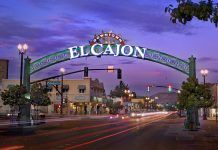During a virtual Aug. 26 public hearing, San Diego County Independent Redistricting Commissioners heard 44 public comments, most from speakers asking officials to consider the immigrant and refugee communities of East County when drawing new lines for District boundaries.
Some, like Majdal Community Center Organizer Ramah Awad spoke in a professional capacity.
“We’ve been testifying that Arabs are not counted as Arab in the census, they’re counted as white. If I’m working with families who have arrived since 2010, they’re not counted at all. However, there’s a direct correlation between political representation and resources for our community,” Awad said, ultimately asking commissioners to keep the Arab-immigrant community intact as one voting block.
Rami Ibrahim, a student who works with the refugee community said he is worried North African refugees will be rendered invisible in the census data.
“San Diego County is home to the largest refugee community in all of California and needs rent relief, access to mental health care. It’s critical that the refugee community that spans from City Heights to El Cajon has representation,” Ibrahim said.
Resident Farida Erikat said the community is, collectively, immigrants, refugees and children of immigrants and refugees.
“We define our community in El Cajon by these boundaries: Broadway to the North, Rancho San Diego to the South, Granite Hills to the East and Highway-8 to the West. Some of our main landmarks are Wells Park, the El Cajon Promenade, Main Street, the Islamic Center of San Diego East County, and Valhalla High School,” Erikat said, then went on to describe the community as having mutual practices, food and languages that drive similar concerns around language access, housing, bullying in schools and COVID-19.
For many years, Erikat said, immigrant community members have paid taxes and contributed to the cultural vibrancy of District 2 as entrepreneurs, yet lacks critical representation due to the way lines were previously drawn.
“It is imperative that the large refugee community be maintained in a single district to ensure representation and distribution of critical resources,” Erikat said.
Resident Salma Hasan asked that the El Cajon refugee community be redistricted with City Heights, specifically to keep immigrants together as one voting block.
Just one public comment, submitted by La Mesa Resident Amy Reichert suggested commissioners consider geographical boundaries in redistricting.
“I came to this county when I was four, in 1972 and I’ve lived all over the county: Mission Beach, Tierrasanta, 20 years in Chula Vista and now own a home in La Mesa. I want to encourage the commission to remember: East is East and West is West. There are very distinct geographical areas that most San Diegans, regardless of race, can identify as being part of one area,” Reichert said.
That stood in direct contrast to speakers like Coordinator with Arab Community Center Coordinator Yasmeen Obeid, who said she wanted community members to be kept in one block.
“I’m here today to speak on how important it is for our community members in El Cajon to be kept in one block with other community’s immigrant refugee members. I’m here to lift their voices up and ask you to consider keeping them together,” Obeid said.
One of the final speakers who accessed the meeting via Zoom and identified herself as an Arabic-Muslim refugee moved to the County from Syria four years ago and said she too would like to see the immigrant communities kept together in order to advocate for better resources like language services.
Residents can submit comments to redistricting@sdcounty.ca.gov or attend committee meetings at www.sandiegocounty.gov/redistricting on the second and fourth Thursdays of every month.














